Chapter 5
Ponting Brothers Ltd
By 1871 all the remaining members of Henry and Jane Ponting's family (aside from Ashfield who was in Devon) seemed to have moved to London and to have begun work in the drapery business.
The Pontings were by no means the first of a new generation of entrepreneurs to arrive in the city to set up shop. One of the earlier arrivals was Peter Robinson, the son of a Yorkshire haberdasher who had opened a linen drapers shop in Oxford Street in 1833, but it was not until 1850 and 1860's that the first department stores began to appear.
William Whiteley arrived in London in 1855 and having worked his way through a number of traditional positions within the industry he set up on his own in Westbourne Grove in 1863. John Lewis came to London from Somerset and after working as a buyer for Peter Robinson he set up in business in 1864. John Barker came to London in 1858 and following employment with Spencer, Turner and Boldero, went to work for William Whiteley, only to set up on his own in Kensington High Street in 1870 when Whiteley refused to make him a partner. Whilst Whiteley and others are considered the forerunners of the "department store" this does not undermine the achievements of the Ponting Brothers.
Much of what follows, particularly in relation to the premises from which Ponting's operated comes from the "Survey of London' Volume 42 - Kensington Square to Earl's Court (1986)" .
The Establishment of the Business
The "Survey of London" records that "the first of the four brothers Ponting to desert his home town ............and make his mark in the expanding metropolitan drapery trade was Thomas, who opened a shop in Archer Street, off Westbourne Grove, in about 1863. William, Sydney and later John Ponting probably learned the business in Archer Street and then at No. 123 Westbourne Grove, Thomas H. Ponting and Company's address from 1868".
The census returns tell that both Thomas Ponting and John Jones Ponting were in London by 1861. Thomas was an assistant to and living with William B Barnes, linen draper at 68 Upper Street, Islington. John was an assistant linen draper to Owen Evans with whom he was living at 35 Stephenson's Terrace, St Mary's, Islington. There is no trace of either William (but see Chapter 10) or Sydney who would have been around 17 and 14 years old respectively.
The 1871 census confirms Thomas had set up at 123 Westbourne Grove by that date and the indications are that John was working with him. Thomas, John and sister Mary are all described as drapers employing four assistants. The four assistants are named on the census returns. There is still no trace of William (now aged 27). Sydney is part way through an apprenticeship, living at High Street, Egham, Surrey with William Hunt. Evidence suggests that Thomas was to remain in business independently. Thank you to Keith Goold for this photograph of Westbourne Grove showing (to the left of centre) "T H Ponting & Co., 121, 123 & 125 Westbourne Grove".

The "Survey of London" goes on to say that Ponting Brothers was set up as an independent concern in 1873 by the younger brothers at No. 125 Kensington High Street, between the railway station and Wright's Lane. The indenture dissolving the partnership between William, John Jones and Sydney Ponting (see below) refers to a partnership agreement between the three brothers dated 19 February 1875. This is two years later than indicated elsewhere, but it may be that 1875 simply when matters were formalised.
Ponting Brothers is described retrospectively as 'a small Berlin wool shop'. It is said that profiting from their position, the partners were able to make their shop into 'the largest retail fancy goods and silk business in London'. The brothers began the process by acquiring Number 127 Kensington High Street (1876) and Numbers 123 and 123A Kensington High Street (1890). Their next step was to acquire Scarsdale House, "the venerable but forlorn mansion immediately behind their premises" in 1893, although initially it was used '"for domestic purposes", presumably for housing assistants.
The Survey quotes from "Shops and Shopping 1800 - 1914 - Where and in What Manner the Well-dressed Englishwoman Bought her Clothes". by Alison Adburgham. It was in this publication that I found my first reference to the Ponting Brothers and this was instrumental in my tracing the family back to Gloucestershire. Here the Pontings arrival in London is described as follows:
"The Ponting's had arrived in Kensington High Street. Four brothers William, Tom, John and Sydney Ponting had left Gloucester to seek their fortunes in London. Tom Ponting started on his own in Westbourne Grove, putting his little bit of money on the district that William Whitely had made so fashionable for shopping. The other three brothers foresaw an even rosier future in Kensington, and time proved them right. They bought just one property, 125 High Street and opened as drapers and milliners. They expanded by acquiring property on either side, and by the end of the century owned 123, 123a and 127 High Street, and also Scarsdale House, formerly the mansion of the Curzons of Kedleston, who held the barony of Scarsdale. At first the mansion was 'adapted and coordinated with the shop premises' and much later pulled down to make way for a new modern store building. This must surely, have been one of the first example of a stately home being acquired for retail trade"
"The purchase of Scarsdale House marked the peak of Ponting's prosperity, when according to a contemporary trade directory, their reputation was at its highest as 'the largest retail fancy goods and silk business in London'. Pontings great specialty was 'supplying everything for the practice of art needlework in its myriad branches especially church work; wools' silks, cotton, card mounts, plush goods, cloths and specimen of commercial work in toile - crosse, cross stitch and roman work, with all required for finishing the same.......................devices and designs supplied for book marks, lam bags, pulpit hangings, altar clothes, etc. such work prepared, executed age mounted' . One can see that it was a favourite shop with the ladies of St Mary Abbots, Church Street. Moreover Pontings claimed to have royal patronage from Kensington Palace".
"Pontings also ran a 'school of needlework' under the direction of a lady of high attainments and long experience, which affords full instruction at moderate rates to pupils in all branches of this desirable art'. This was surely a piece of splendid business acumen, creating a demand for your own goods on your premises and getting money for so doing".
From 1875 to 1880 William, John and Sidney Ponting are shown on Kensington and Chelsea electoral register by virtue of their interest in 125, Kensington High Street. When William married in 1878 he gives his address as High Street, Kensington.
At the time of the 1881 census William and his family are shown as living at 125 to 127 High Street, Kensington. Aside from 36 year old William's family, there was a drapers clerk, 6 drapers assistants and 4 apprentices living on the premises. John was boarding at 92 Talbot Road, Paddington and is described as a "retired draper" although this does not appear to be the case and Sydney and his wife were living at 1 Cheniston Gardens, Kensington, quite close to the shop and they had 5 drapers assistants living with them.
From 1882 the electoral register lists William by virtue of his interest in 125 Kensington High Street and John Jones Ponting by virtue of his interest in 126 Kensington High Street. In 1883 and 1884 all three brothers are again listed with an interest in 125 Kensington High Street, but only William is resident. John's address is 91, Talbot Road and Sydney's, 1 Cheniston Gardens.
Sydney left the business soon after this. Papers held in Gloucestershire Archives (D9400/5/5/3) include an indenture for the dissolution of the partnership between John Jones Ponting, William Ponting and Sydney Ponting in which Sydney retired from the business of "court milliner and fancy draper" in Kensington High Street in 1884.
The indenture dated 7 October 1884 is between Sydney, William and John Jones Ponting, who are again all described as " court milliner and fancy draper" of 125 Kensington High Street. It refers to an agreement between the three to carry on the business in partnership in equal shares for 21 years from 19 February 1875 and notes that it had carried on until 19 February 1884.
It goes on to say that a statement of account had been made out, signed and settled between the three of them whereby Sydney's share of the capital was stated to be £202 6s 6d (about £14.5K in 2006) and his share of stock in trade, money, credit and effects after debts at £893.00s 0d (nearly £64K in 2006). Since then, Sydney had received £161. 10s 7d on account of the £893.00s.0d and is entitled to £27.2s 5d interest leaving £759 1s 10d due (of the £893.00.0?).
The following was also agreed
- Sydney retires from 19 February 1884 and William and John Jones will carry on in partnership subject to any terms and conditions that they agree
- William and John Jones will pay Sydney £259. 1s 10d being part of the £759 1s 10d on signing the agreement and the remaining £500.00s.0d in 3 instalments, £166 13s 4d on 25 April 1885, £166 13s 4d on 25 August 1885 and £166 13s 4d on 25 December 1885. Interest will be paid half yearly on 31 August and 28 February.
- The £202 6s 4d for the capital will remain on loan to William and John Jones with interest "at the rate of £5.00.0 per cent per annum" payable half yearly on 28 February and 31 August. Sydney was not entitled to require repayment for 5 years, but William and John Jones may pay off the loan or parts of it during that period but only with instalments of £500 or more.
- William and John Jones will indemnify Sydney against partnership debts
- Sydney accepts £961 8s 4d in "full satisfaction" of his share/interest in the capital, stock in trade, credit and effects of the partnership and its goodwill.
The indenture also states that Sydney will not either alone or in partnership or as an assistant or as a traveller carry on the trade of court milliner and fancy draper within 2 miles of 125 High Street, Kensington.
Finally Sydney appoints John Jones and William as his attorneys to make payments on behalf of and to collect any debts due to the dissolved partnership, to take any action necessary to recover moneys and to perform any acts that he could have done had the partnership not been dissolved. John Jones and William release Sydney from all agreements and provisions of the former partnership deed.
The copy of the indenture is then signed by William and John Jones Ponting (below)

The London Gazette dated 31 October 1884 reported
"Notice is hereby given, that the partnership heretofore subsisting between the undersigned William Ponting, John Jones Ponting and Sydney Ponting in the business of Court Milliners and Fancy Drapers at 125 and 127 Kensington High-street was dissolved, by mutual consent, from which date it will be carried on by said William Ponting and John Jones Ponting alone. Witness our hand this 27th day of October 1884
William Ponting
John Jones Ponting
Sydney Ponting"
A statement of account between Sydney and the remaining Ponting Brother's covering the period from 1885 to February 1889 has also been located. Extracts of this are shown below. The initial entries in the right hand column are the figures quoted in the agreement terminating the partnership. The statement of account goes up to the end of 1889, at which point Ponting Brothers still owed Sydney £23. 19s.4d.

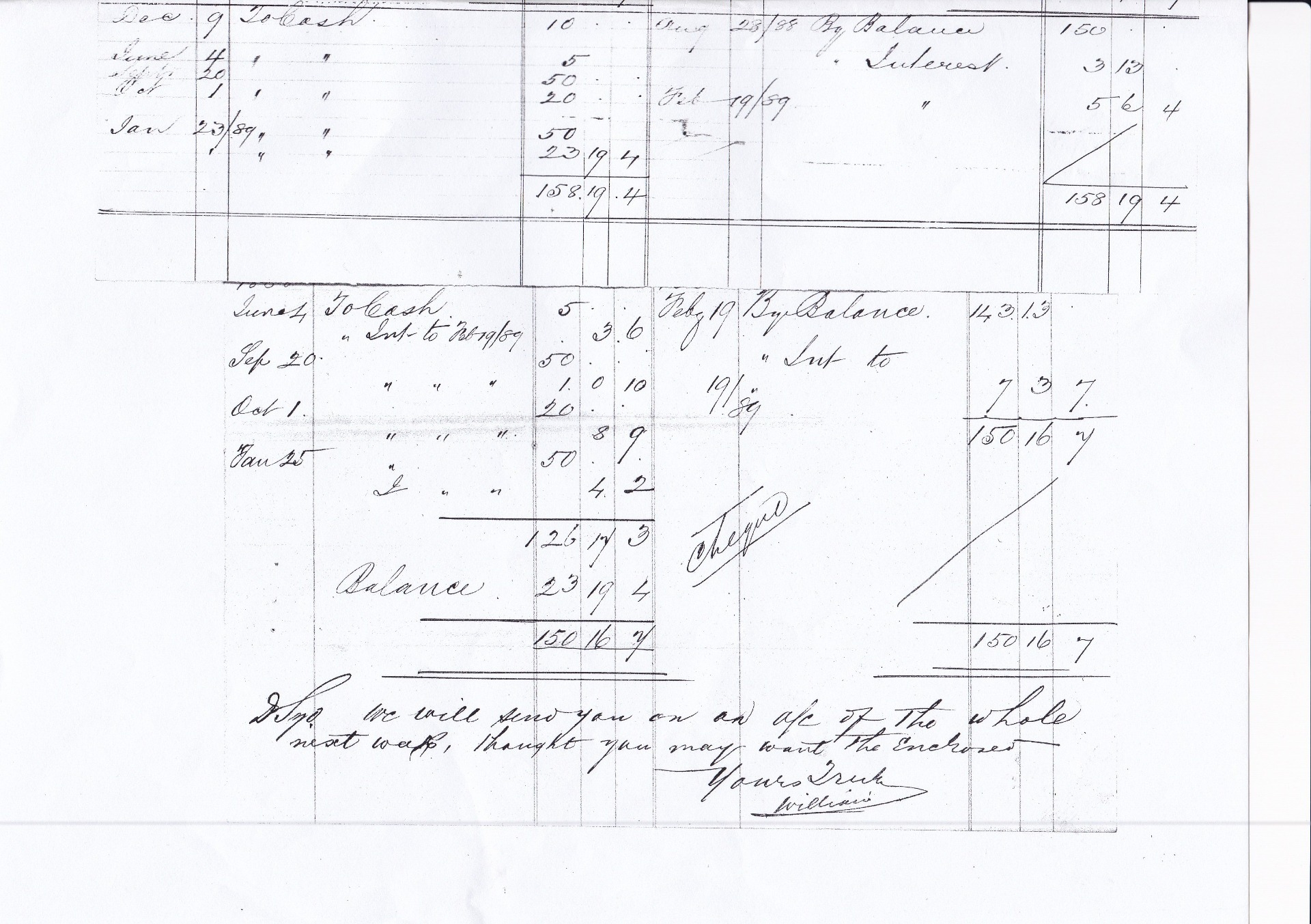
William signs off this account to his brother with the words
"Syd. We will send you on an a/c of the whole next week, thought you may want the enclosed. Yours truly William"
And so, the business continued.
In 1888, 1889 and onwards only William and John Jones Ponting are listed on the Kensington and Chelsea electoral register by virtue of their interest in 125 Kensington High Street. John Jones Ponting was resident at 91, Talbot Road and William at 127 Kensington High Street.
In 1891 William and Emily are still living in Kensington High Street but are shown as occupying 123 to 127 High Street. Including their staff who were also resident at 127a High Street, the business was by then employing 32 drapers assistants', 6 drapers apprentices, 4 drapers clerks', 2 caretakers and 7 house servants. Sydney has been back in Gloucestershire for around 7 years and John Jones Ponting is living at Barnes with his 2nd wife and young family.
This and the earlier census returns support the idea that It was common for owners of businesses to reside with their live-in assistants. As firms prospered and pressure for space increased, the owners tended to move out, while the assistants (many of whom were not Londoners) continued to be housed by their employers although increasingly in nearby annexes. This seems to be the case with the Kensington High Street business and Thomas Ponting's business in Westbourne Grove (Chapter 6).
The Premises
Ponting Brothers originally started trading at 125 High Street, Kensington in 1873, expanding to 127 High Street in 1876. Numbers 123 and 123A High Street were acquired in 1890. Scarsdale House was acquired in 1893 after Sydney left the partnership. The role of Scarsdale House in the business has been worthy of note by some historians.
Built in the early 1690's Scarsdale House was the largest of the houses built by Francis Barry on his estate. The detached mansion stood in a walled garden set back from the east corner of Kensington High Street and Wrights Lane. It had four acres of gardens stretching southwards to a fishpond and a 'canal'. There were coach-houses, stables' and offices to the north of the main house next to the High Street. The property was entered from a gateway near the top of Wright's Lane.
It appears that Barry lived there until about 1697, when financial problems caused him to move to a smaller dwelling. A series of residents of "high standing" followed and in 1720, the freehold was sold to William Curzon, a wealthy lawyer, whose family retained the title for nearly two centuries.
Curzon, later an M.P, lived there for some time, perhaps until his death in 1749. The freehold of the property passed through the main line of the Curzon family. By 1755 the house had been let on a short term basis as a school, and it continued to be used as such until at least the 1840s.
In 1783 John Robinson, a lawyer, acquired a long lease of the whole property. He employed Michael Dowse, a carpenter, to build three houses next to the High Street, on the site of the stables to the north of the main house. These were all leased and tenanted in 1789-91. It was these that eventually became 123 to 127 (odd) Kensington High Street and were to be the original premises of Pontings.
The Curzon family bought back Robinson's leasehold interest in the whole estate at auction in 1807. This watercolour of Scarsdale House painted in 1815 by H Oakes Jones was taken from the Library Time machine. See here

Between 1823 to 1825, Scarsdale Terrace, a row of 18 residential cottages, was erected in the southern half of the old garden fronting the eastern side of Wright's Lane.
In 1846 Scarsdale House was acquired by Edward Cecil Curzon (1812-85), a barrister and registrar of patents, for his family to occupy.
In the 1860's he was forced to give up part of the land to the east side of his property to the Metropolitan Railway. However, census returns (1851 through to 1881) show he continued to live at Scarsdale House throughout this period and he may have remained there until his death aged 72 in 1885 (Reg Gen March Qtr. 1885 Kensington 1a 102).
By the time of Curzon's death, Pontings already held a lease on 125 and 127 Kensington High Street. According to the "Survey of London", leases on Number 123 and 123A were not acquired until 1890. The 1881 census seems to confirm this, as at that time the occupants of 123 High Street at the time were draper Edward Mayes, a 46 year old widower, his son and 4 drapers assistants and the occupants of 123A High Street were John Sutton, a warehouseman, his wife and son.
Scarsdale House was acquired by the Ponting's in 1893. There had been an auction of Curzon's estate by his son in 1886 but this proved unsuccessful. In 1893 the process of dissolving the estate began, when the Midland Railway bought Scarsdale Terrace and some of the remaining garden, while Pontings took over Scarsdale House. This picture of Scarsdale House is also taken from the Library Time Machine.

See
- Forgotten Buildings: Scarsdale House | The Library Time Machine (wordpress.com)
- Scarsdale House, Wrights Lane, Kensington, 1892 (#401260) (meisterdrucke.uk) and
- Kensington High Street, south side: Wright's Lane to Earl's Court Road | British History Online (british-history.ac.uk)
Pontings were said to have virtually dismantled the interior, but that the shell of the building still existed in 1899, when readers of The Warehouseman and Draper were assured that it was 'built in the reign of James I as a hunting box, for his Majesty', and contained 'a haunted room associated with a legendary murder which is to be pulled down to make way for an up-to-date tea and retiring room for customers.' . Soon after that the old Scarsdale House disappeared under one of the many extensions to the Pontings premises (see below).
An ordnance survey map dated 1871 and covering St Mary Abbotts, Kensington although some time before Pontings occupied all the property they were to hold, does seem to show the buildings from which they were to operate prior to the demolition of the "old" Scarsdale House.
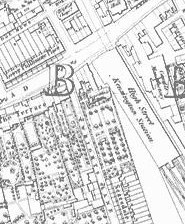
Most of the photographs seen of Ponting's premises were taken sometime after incorporation and therefore after the redevelopment of most of the site.
However I believe that the photographs below predate some of the development and may show the old 123, 125 and 127 Kensington High Street as they were when they were acquired by the Ponting Brothers. They certainly predate the redevelopment of Kensington High Street Railway Station in 1906.

And these two from The Library Time Machine

Looking down Wrights Lane
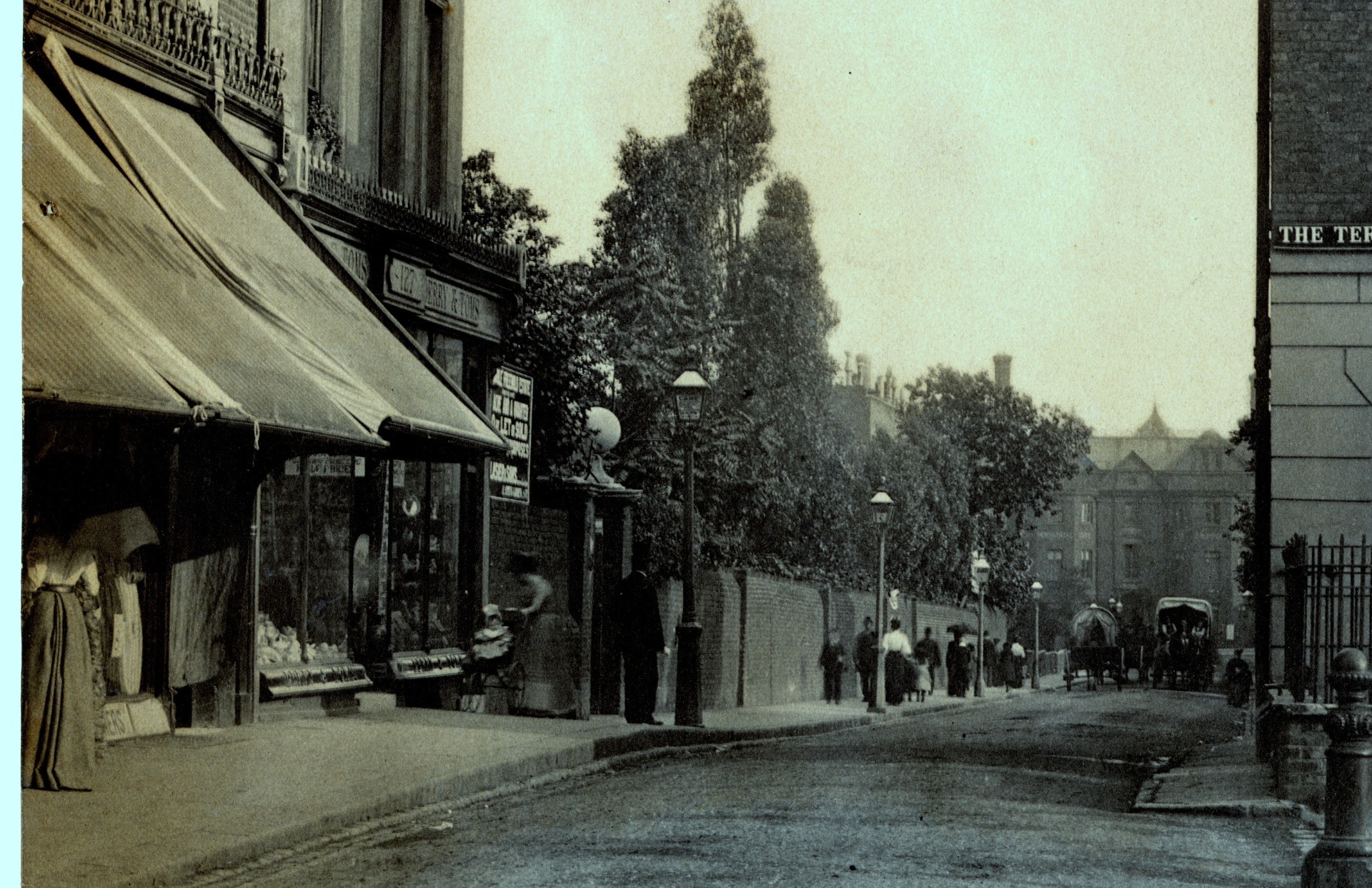
The Incorporation
In 1898 Ponting Brothers Ltd was incorporated. The records of incorporation are held at the National Archives at Kew (PRO BT31/7991/57434).
The company was incorporated on 20 May 1898 with authorised share capital of 60,000 £1 ordinary shares. The articles of association indicate that it was to carry on the business previously carried on "for many year" by William Ponting and John Jones Ponting. The articles indicate a wide and varied range of products, but articles of association do not simply reflect the current activities of the business but are designed as a "catch all" to enable the company to diversify into other businesses as appropriate.
Only seven shares were initially issued to:
- W Ponting of 123/127 High Street, Kensington
- John Jones Ponting of 123/127 High Street, Kensington
- W J B Tippett of 11 Maiden Lane, EC
- A I Tippett of 11 Maiden Lane, EC
- Vickers Dunfeel (?)
- S Spencer, civil engineers of 44 Hexham Gardens, London
- C J Skinner of 4 Norman Villa's, London
Messrs Tippetts & Sons, 11 Maiden Lane, Queen Street, London, EC were the solicitors acting in this matter.
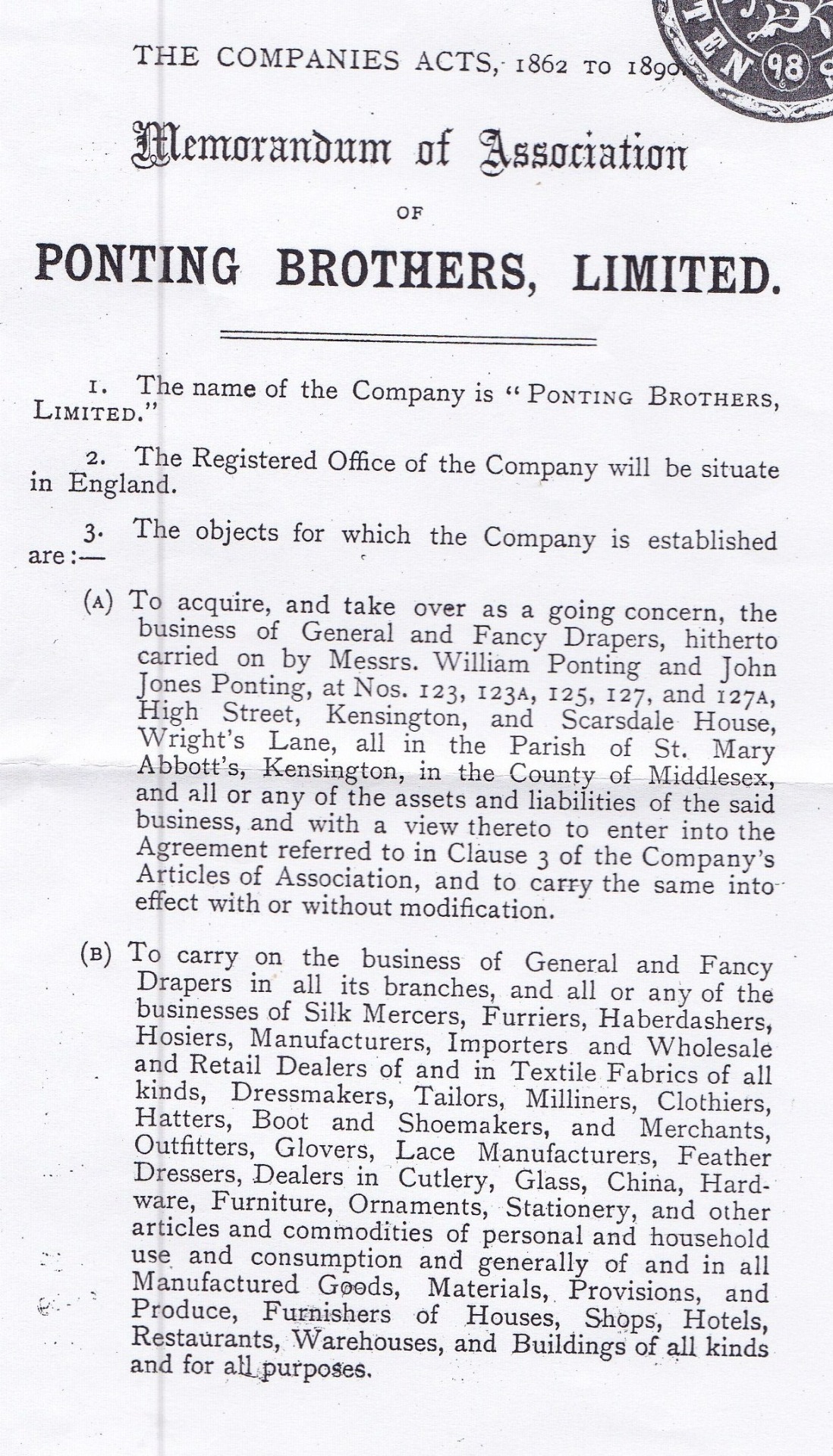
The company acquired the business of Ponting Brothers (assets, goodwill and exclusive right to the name) under an agreement dated 19 February 1898. The agreement provided that Ponting Brothers Ltd would acquire:
- The lease of Scarsdale House (held between George Augustus Curzon and Messrs Ponting from 1892 at an annual rent of £650.00s.00d), the lease of 123 High Street, Kensington (partly owned by Edward Curzon and partly by Metropolitan Railways leased for 80 years from 24 July 1875 at an annual rent of £175.00s.00d) and the lease of 123a High Street, Kensington (belonging to Curzon and leased for 80 years at an annual rent of £125.00s.00d from 24 July 1875). These were purchased by the company for £70,468.14s.00d to be satisfied by the issue of £30,000 of new shares in the company (8 to 30,007) to be issued as directed, £20,000.00s.0d by the issue of 5% debentures to be issued at the directors instructions and £20,468.00s.14d in cash. (a debenture is an acknowledgement of indebtedness , especially a bond of a company or corporation and providing for payment of interest at fixed intervals)
- The lease of 125 High Street, Kensington (held between Richard Thomas Rowley, Edward Cecil Curzon, Amelia Charlotte Curzon and Messrs Ponting from 29 September 1882 at an annual rent of £350.00s.00d). This was purchased for £14,531.04s.00d being the value of the stock on 19 February 1898.
- The lease of 127 High Street, Kensington (held between Richard Rowley, E Curzon, S C Curzon and Charles James Derry and Charles Toms , for 80 years from 29 September 1875 at an annual rent of £250.00s.00d). This was purchased for £1,125.0s.0d payable in cash.
- The lease of 127a High Street, Kensington (dated 15 December 1883 and held between Richard Rowley, E Curzon, S C Curzon and Charles James Derry and Charles Toms for 72 years from September 1883 at an annual rent of £135.00s.00d per annum). This was purchased for £2,138.09s.06d cash
If the dates quoted in the "Survey of London" are correct some of these leases must have been acquired by Pontings from third parties part way through their term.
The agreement contained a clause confirming an agreement with Curzon that Messrs Ponting would pull down 125, 127 and 127a High Street, Kensington and within 15 months complete a rebuild of a shop or shops costing no less than £7,500 including interior fittings at which point a new lease or leases running for 59 years from 29 September 1896 would be issued at a yearly rent for 5 years of £787. 10s.00d and thereafter £937. 10s.00d per annum. This new building would seem to be the new Scarsdale House
Setting aside the debentures included in the purchase agreement for present (as it is not clear whether these were ever paid), William and John Jones Ponting appear to have received around £38, 194 cash for their business. Applying the RPI to that figure, in 2006 this would be equivalent to £2.9M
The purchase agreement also states that following the acquisition of the business by Ponting Brothers Ltd, William Ponting is to be appointed chairman for three years and was to be paid £250.00s.00d per annum (the equivalent of £19K in 2006) plus a dividend of 7%.
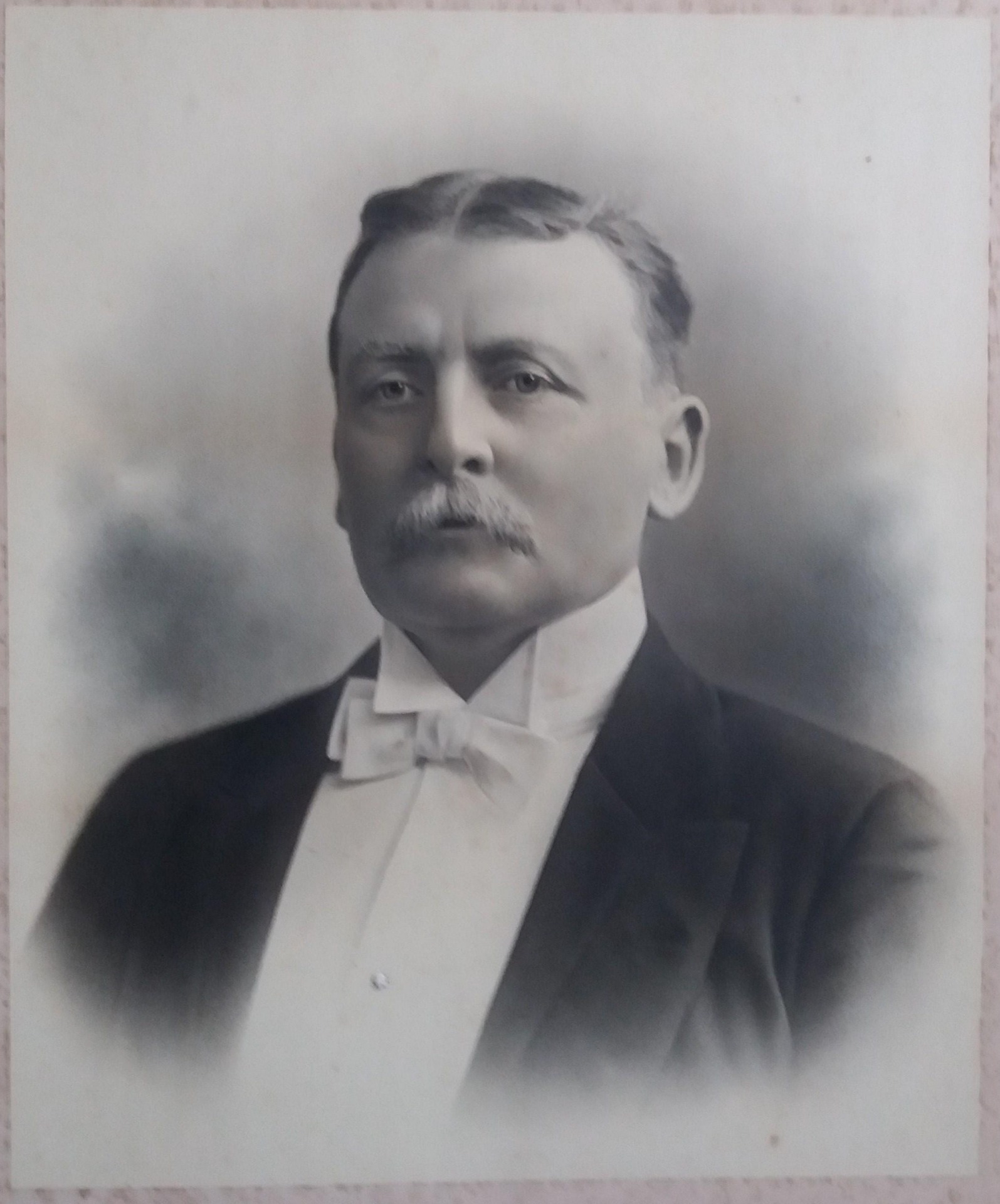
The other directors were to be
- Lord Walter Gordon Lennox
- Henry Charles Richards MP
- Alfred Walford Poulton
However things did not go according to plan and by 26 October 1898 William had died.
After Incorporation
As part of the sale agreement for the business, William and John Jones Ponting were supposed to have received 30,000 of the original shares issued. This would have left them in control of the company. It is not clear whether they ever received these shares, but if they did they do not appear to have held on to them for long.
Certainly by 11 August 1898 William and John Jones Ponting no longer controlled the company. Further share capital had been issued in the interim and of the nominal share capital of £60,000, as at 11 August 1898, £59,151 had been taken up. In addition to the original £1 shares, William owned 14,040 ordinary shares and John Jones Ponting owned 7,460 ordinary shares.
At this point the company had 109 shareholders, with no one having outright control. The shareholders included 11 employees of the business owning between 5 and 100 shares each. Aside from William and John Jones Ponting, the only other family shareholder was Frank Osborne Ponting, a draper of 18 Crondace Road, Parsons Green, London (who had acquired 50 ordinary shares) and was John Jones Ponting's son from his first marriage (Chapter 9).
The "Survey of London" states that the period between 1898 and 1906 was a "the critical phase of Pontings' independent development . In the former year the business had turned into a limited company. The largest shareholder was William Ponting, then resident in Ealing followed by John Jones Ponting of Putney who joined the firm later than the other brothers. The new company embarked on a policy of rapid growth, but almost immediately William Ponting died and the family's direction of the enterprise disappeared".
That the company was expanding was evidenced by authorisation to issue up to yet another £50,000 of preferential shares (ranking in priority to the ordinary shares and receiving a dividend of 5 ½% with no further rights to profit or assets) which was given at an extraordinary meeting on 14 April 1899. The expansion was initially directed by Henry Charles Richards, M. P. who seems to have become chairman following William's death and a new manager from Whiteleys, a Mr. Forbes.
Between 1899-1901 Pontings replaced their makeshift premises facing the High Street with a wholly new store building designed by Arthur Sykes (below). The 'new' Scarsdale House. It was built in two stages and cost at least £14,000.
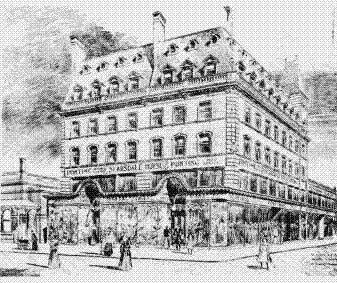
"Its old-fashioned but capacious Italianate structure included a large basement, four full storeys above ground and an extra two in the steep mansard. Towards the High Street, the shop fronts projected beyond the main building line. As planned in 1899, the basement was for delivery, dispatch and accounts as well as for 'heavy goods', turnery, carpets, ironmongery and glass; the ground floor housed 'fancy goods'; while the first floor, arranged in long parallel showrooms, was for millinery, capes, costumes and mantles, with workrooms and a tea room behind.
Above these 120 assistants were accommodated, with communal kitchens, dining-rooms and even a billiard-room, thus relieving pressure on the five outside houses where shop assistants were already living. The new block was annexed to Scarsdale House, which was apparently for the time being reduced to a skeleton rather than destroyed outright".
"Also at this time or soon afterwards, Pontings built a series of four utilitarian blocks or 'divisions' in the remaining Scarsdale House garden, along the east side of Wright's Lane. Flats had been proposed here in March 1899, but by September of that year Pontings controlled this site also and the architects E. N. Clifton, Son and Hope had drawn up plans for the firm. These buildings seem to have taken some time to complete; they were used at first mainly for depositories and offices"
The company had continued to trade during this period of reconstruction, seemingly successfully as is indicated by the advert below from the Daily Mail on Thursday 28 December 1899.
The Daily Mail, devised by Alfred Harmsworth (later Lord Northcliffe) and his brother Harold (later Lord Rothermere), was first published on 4 May 1896. Originally a broadsheet it was the first newspaper aimed at the 'middle market'. It cost a halfpenny at a time when other London daily papers cost a penny and was more populist in tone and more concise in its coverage than its rivals. Soon after its launch it had more than half a million readers.

In 1901 the census shows that there were 67 drapers assistants, 22 drapers clerks, a drapers porter, the manageress of the refreshment room, the furniture buyer, the night watchman living at the Kensington High Street premises and being looked after by a housekeeper, a cook and 10 housemaids . Still seemingly a very successful business.
This. the next earliest advert located, (unusually not for one of it's clothing departments) was in the "Ladies Pictorial" on 23 November 1901

On 12 April 1901 the company took out a £35K mortgage raised on 125 and 127 High Street as security for the issue of debentures and replacing the earlier debentures dated 17 June 1898 (which I presume to be the debentures issued to William and John Jones Ponting as part of the acquisition price).
On 20 February 1903, a further £60K mortgage was raised on the assets and property of the company for the purpose of securing the issue of debenture stocks.
The next record held is a detailed record of shareholders in Pontings is on 22 April 1903. By that time the company had issued £60,000 ordinary shares and £38,290 preferential shares. None of the preferential shares were immediately acquired by the Ponting Family and by April 1903 the Ponting family or their representatives had the following interests in the company
- Wm Jas Bernman Tippets, 11 Maiden Lane, E6, solicitor and Arthur Ponting of 1 Micheldover Road, draper - 12,341 ordinary shares (executors/trustees of William Ponting)
- John Jones Ponting, Warminster Road South, Norwood, SE25, Gentleman - 6,501 ordinary shares (John Jones Ponting had disposed of 200 shares on 27 November 1902 and 200 shares on 16 February 1903)
- Arthur Ponting, Micheldover Road, Lee, SE, draper - 200 ordinary shares
- Frank Osborne Ponting, 609 Old Kent Road, draper - 50 ordinary shares
What remained of William's shares were being held in the trust created on his death (Chapter 10).
The executors of Emily Maria Ponting (Chapter 10) had transferred 300 shares on 3 November 1902. It is not clear how or when she came to acquire these shares or to whom they were transferred.
Arthur Ponting was a first cousin to our Ponting family (Appendix J). I have prepared the attached chart hopefully showing the relationship between the various Ponting family member who were connected to the Ponting's store and the drapery business more widely.

The directors in April 1903 were
- Henry Chas Richards, 2 Mitre Buildings, E6 (chairman)
- Alfred Walford Poulton, The Gables, Grove Park, Kent
- Wm Henry Hunt, 25 Denmark Avenue, Wimbledon, (draper)
- Henry Griffiths, 123 High Street, Kensington, (Managing Director)
This seems to indicate that John Jones Ponting had no more to do with the running of the company than before his brothers death.
At 18 July 1906 the family shareholdings remained the same as at 22 April 1903 aside for the fact that Arthur Ponting had acquired 250 preferential shares whilst Frank Osborn Ponting had transferred his 50 ordinary shares on 4 July 1905.
The directors at the time were:
- Robertson Lawson, 1 Harley Street (chairman)
- Arthur Ponting, Taynton, Kenley, Surrey
- Samuel Rogers, 9 Addle Street
- Sarah Annie (?), 43 Epple Road, Fulham.
Arthur Ponting, director is the same cousin Arthur who owned the shares but he had moved from Micheldover Road to Taynton, Kenley.
To finance the building work described earlier, the company had been forced to take out several mortgages, as described above, which had put a strain on finances. The company's problems came to a head when at the turn of the century the Metropolitan Railway decided to reconstruct the High Street, Kensington station. George Sherrin's scheme of 1903-1904 proposed, amongst other things, the creation of a central arcade leading from the railway station to the street. Pontings rashly took the whole western side. The plan materialised as the premises illustrated below.
Construction here was proceeding to the plans of architect A W Cleaver, when the company went into liquidation in December 1906.

The Liquidation
The records for Ponting Brothers Ltd (PRO reference BT31/7991/57434) show that following extraordinary general meetings on 13 December 1906 and 28 December 1906 it was agreed that the company should be wound up voluntarily and Algernon Osmund Miles of 28 King Street, Cheapside would be appointed to liquidate the company.
Documentation relating to the winding up can be found at the Public Records Office (J13/4604).
This indicates that at the same time as the company was being wound up it was being sued by Goddard Brothers Ltd of 158 Percy Road, Shepherds Bush, London - coachbuilders. They had commenced action for the recovery of £14.09.06 for work undertaken on carts and vans. Judgement had been obtained against Pontings, but on 30 January 1907 the company's liquidator, A O Miles went before the High Court of Justice (Winding Up) advising them of the liquidation and asking for an order to refrain Goddard's from enforcing judgement. This was to prevent the coachbuilders getting preference (over other creditors). The order was granted.
In Miles' affidavit dated 29 January 1907 he states that the company had debts and liabilities of £123,055 and assets of £128,019. The assets were principally leasehold properties with heavy rents and so it was unlikely that the company could raise enough to pay its debenture stockholders who were now due their money. The company was insolvent.
On 22 February 1907 all interested parties were ordered to attend the Chambers of the Registrar of The High Court of Justice (Winding up) to hear an application by Miles to enable him to carry on the business as liquidator.
On this occasion in his affidavit, Miles details the company debts as including
- A £35K mortgage debenture dated 17 June 1898 bearing interest at 5% per annum and secured between the company and Henry John Gardener and William James Bernham on the properties at 123, 123a, 125, 127 and 127a High Street Kensington and certain other leasehold premises.
- £60K of debenture stock secured by a trust deed dated 20 February 1903 between the company and The National Safe Deposit Company Ltd as trustees for the debenture stockholders in which the company conveyed certain freehold property in King Street in the parish of St Mary Abbott, Kensington, and other leased properties.
Miles concluded that on 11 November 1906 the securities in the February 1903 trust deed had become enforceable and he was appointed as receiver to enter and take possession of the properties. Since then as 'the business is well known and as a going concern is valuable' he had entered into various negotiations which remained pending and which could result in substantial offers. He believed these would be sufficient to pay off the debenture holders and pay a dividend to the unsecured creditors.
In short, after incorporation, Ponting Brothers Ltd had borrowed a lot of money and couldn't afford to pay it back.
On 12 April 1907 the matter went before the High Court of Justice again. In his affidavit Miles sets out an offer received from Barker & Co which includes
- £84K for all the leasehold and other premises, excluding the stables at King Street, but including vacant land and the new premises being constructed
- The purchasers will pay for the costs of construction under the building agreement with Metropolitan Railways, less the £1,100.00 already paid by Ponting Brothers Ltd
- Stock is guaranteed by the vendors at £28K
- Book debts are to be met by the vendors
- The premises are to be free of mortgages
- The purchasers will pay the receivers
Miles concluded that £63K for the premises and £21K for the stock was the most he believed he would get. He believed that there was no value in the goodwill apart from the premises. He also pointed out that the vendors had been going to pay for the premises now being built and so the buyers would take over a liability of between £17K and £20K.
This was supported by an affidavit from William Henry Wells, chartered surveyor and partner in Chesterton & Sons, auctioneers and surveyors. He valued the premises on Kensington High Street at £53K and the back part of the premises at £16K (£69K in total) and this was without taking into account the building agreement with the railway. He believed that an offer of £63K would be proper for the premises and fixtures. He said his opinion took into account ' the general business depression in Kensington High Street and the large numbers of properties available to let'.
Matters were not concluded quite that simply though. On 15 August 1907 Albert William Cleaver, architect, applied to the court, to have his bill treated as a winding up expense and so be treated as a preferential creditor. He had been appointed in connection with the work being undertaken on the land owned by the Metropolitan District Railway Company (see above). In his affidavit he stated that after the liquidation he continued to work for the company. He had been in communication with the manager of the company, Mr Henry J Jack, but had not been advised of the liquidation. He said he 'had been informed by Mr Arthur Ponting, a former director of the company and believed that negotiations for the building of the new premises were entered into with the knowledge and consent of the trustees'. He concluded that he believed that John Barker would not have paid the price it had if the building work had not continued. The work undertaken was necessary for the beneficial winding up of the company and his bill is an expense of the winding up.
It appears to take Miles until 8 October 1907 to come back to the court. In his next affidavit, amongst other things, he denies ever sanctioning anyone to employ Cleaver. He states that H J Jack managed the company's retail business and it was not part of his duties to represent Miles or to give instructions to architects, etc. No mention is made of Arthur Ponting.
Following a further affidavit from Cleaver, the courts considered the claim and on 27 November 1907 ordered that Miles should pay Cleaver, subject to some reduction in costs.
On 27 February 1908 Cleaver's costs are agreed at £45.14.2.
Towards the End of the Road
So in 1907 John Barker & Co Ltd purchased the business and premises of Ponting Brothers Ltd.

The following adverts relate to after this period,
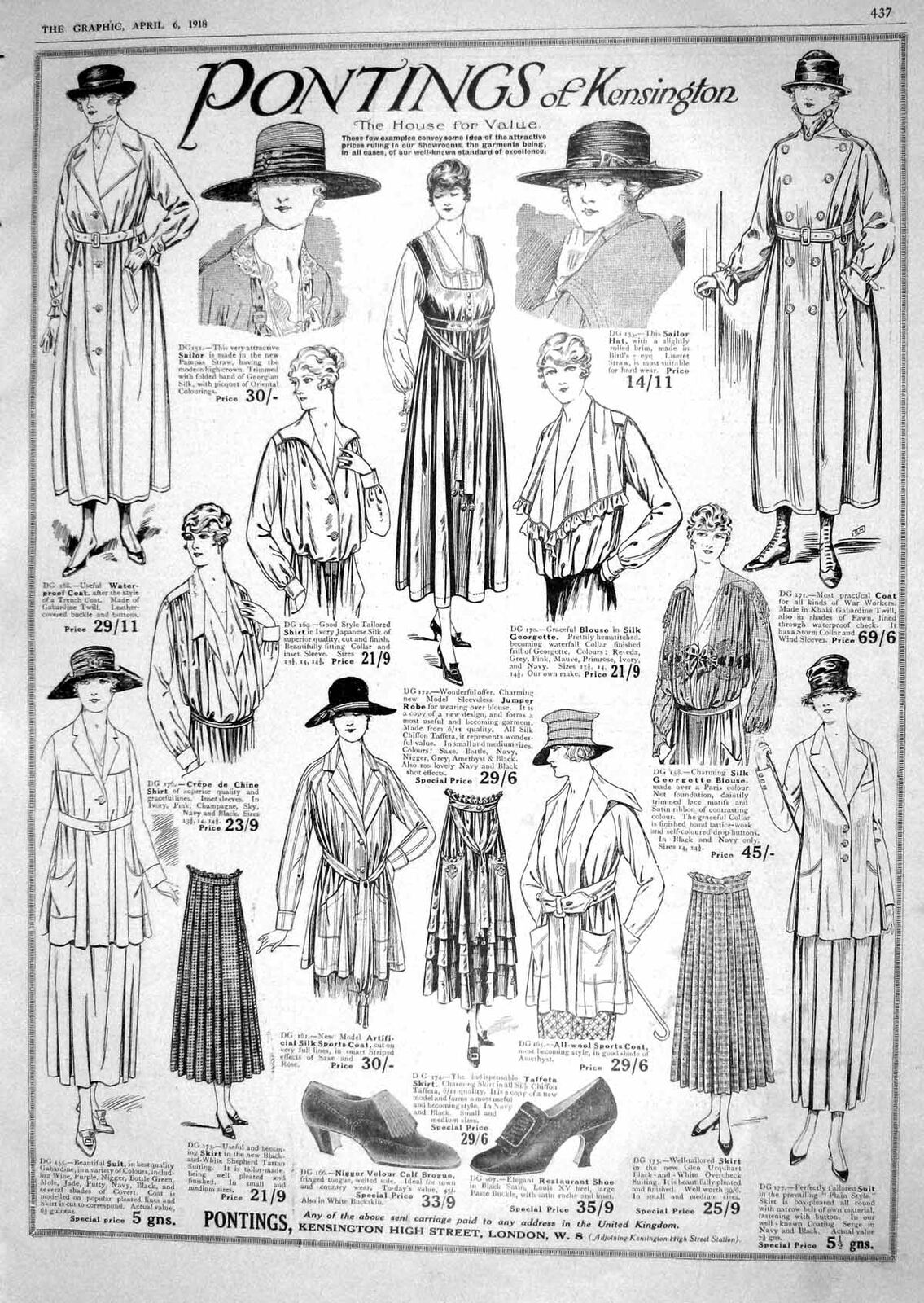

The store was refurbished in 1922 and extended in 1923. In about 1929, it was developed southwards along Wrights Lane. This postcard is from 1929, but shows the view of Kensington High Street rather than that down Wrights Lane.

In August 1957, John Barker & Co Ltd was acquired by House of Fraser Ltd, department store retailers, of Glasgow. The photograph below was taken in April 1959. It shows Pontings on the corner of Kensington High Street and Wrights Lane and is the new 'Scarsdale House' after all the redevelopment referred to above and as it was when it closed.
In 1970 it was decided to close the Pontings store and to move the business to the lower ground floor of Barkers in Kensington High Street where it was to be known as "Pontings Bargain Basement - The House of Value".
The Pontings department store closed for the last time at end of business on Saturday 13 February 1971 and in the 40 hours that followed the entire operation was moved to the basement of Barkers, some 100 yards up the road. The "Pontings" name was abandoned for trading purposes in 1974 and the basement was re-named Barkers Bargain Basement". The old Pontings store was demolished in May 1976.

And finally, in January 2006, Barkers Department Store in High Street, Kensington closed after 135 years. The House of Fraser who had taken over Barkers decided that the business did not fit in with its portfolio as many shoppers were now shopping in the West End.
Click here to go to "Chapter 6 - Thomas Hewett Ponting"
Click here to go to "Chapter 9 - John Jones Ponting"
Click here to go to "Chapter 10 - William Ponting"
Click here to go to "Chapter 11 - Sydney Ponting"
For more information on Arthur Ponting click here and go to "Appendix J - The Children of Charles Ponting and Sarah Hooper"
Click here to go back to "Chapter 4 - Henry Ponting and Jane Jones"